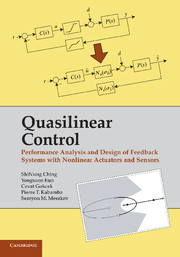 Quasilinear Control
Quasilinear Control Book contents
- Frontmatter
- Contents
- Preface
- 1 Introduction
- 2 Stochastic Linearization of LPNI Systems
- 3 Analysis of Reference Tracking in LPNI Systems
- 4 Analysis of Disturbance Rejection in LPNI Systems
- 5 Design of Reference Tracking Controllers for LPNI Systems
- 6 Design of Disturbance Rejection Controllers for LPNI Systems
- 7 Performance Recovery in LPNI Systems
- 8 Proofs
- Epilogue
- Abbreviations and Notations
- Index
- References
6 - Design of Disturbance Rejection Controllers for LPNI Systems
Published online by Cambridge University Press: 01 June 2011
- Frontmatter
- Contents
- Preface
- 1 Introduction
- 2 Stochastic Linearization of LPNI Systems
- 3 Analysis of Reference Tracking in LPNI Systems
- 4 Analysis of Disturbance Rejection in LPNI Systems
- 5 Design of Reference Tracking Controllers for LPNI Systems
- 6 Design of Disturbance Rejection Controllers for LPNI Systems
- 7 Performance Recovery in LPNI Systems
- 8 Proofs
- Epilogue
- Abbreviations and Notations
- Index
- References
Summary
Motivation: The LQR and LQG techniques are widely used for designing disturbance rejection controllers for linear systems. In this chapter, quasilinear versions of these techniques are developed and extended to simultaneous design of controllers and instrumentation, that is, actuators and sensors.
Overview: We begin with developing the SLQR/SLQG technique, where the “S” stands for “saturated” (Section 6.1). Then, we extend LQR/LQG to the so-called ILQR/ILQG (where the “I” stands for “instrumented”), which is intended for simultaneous design of controllers, sensors, and actuators (Section 6.2). For each of these methods, we show that the solution is given by the usual Lyapunov and Ricatti equations coupled with additional trancendental equations, which account for the Lagrange multipliers of the associated optimization problems and the quasilinear gains. Bisection algorithms for solving these coupled equations are provided.
Saturated LQR/LQG
Scenario
The LQR/LQG design methodology is one of the main state space techniques for designing linear controllers for linear plants, assuming that the actuators and sensors are also linear. Clearly, this methodology is not applicable to nonlinear systems. Is an extension to LPNI systems possible? A positive answer to this question is provided in this section for systems with saturating actuators. The resulting technique is referred to as SLQR/SLQG, where the “S” stands for “saturated.” Extensions to other nonlinearities and to nonlinearities in actuators and sensors simultaneously are also possible using the approach presented here.
- Type
- Chapter
- Information
- Quasilinear ControlPerformance Analysis and Design of Feedback Systems with Nonlinear Sensors and Actuators, pp. 167 - 203Publisher: Cambridge University PressPrint publication year: 2010


